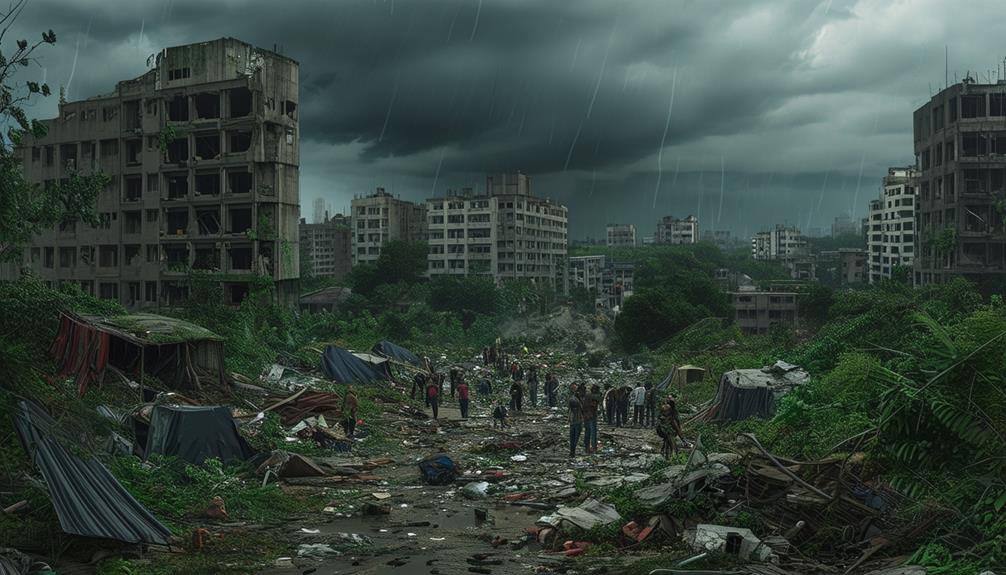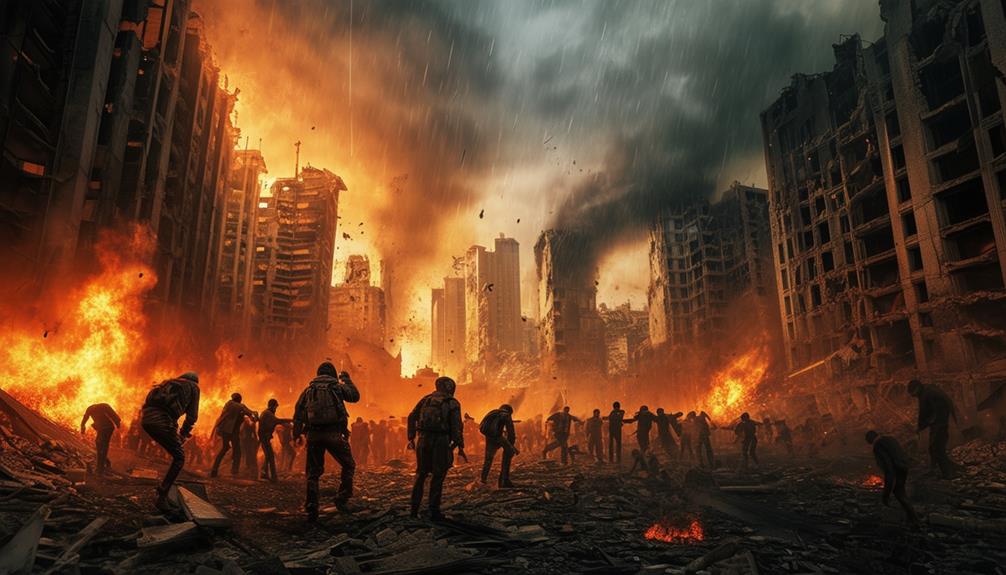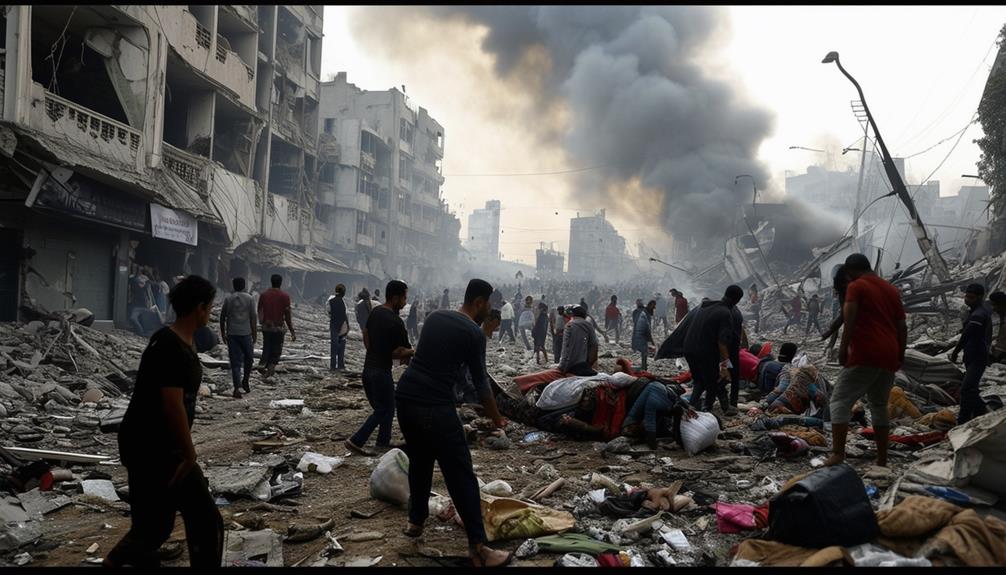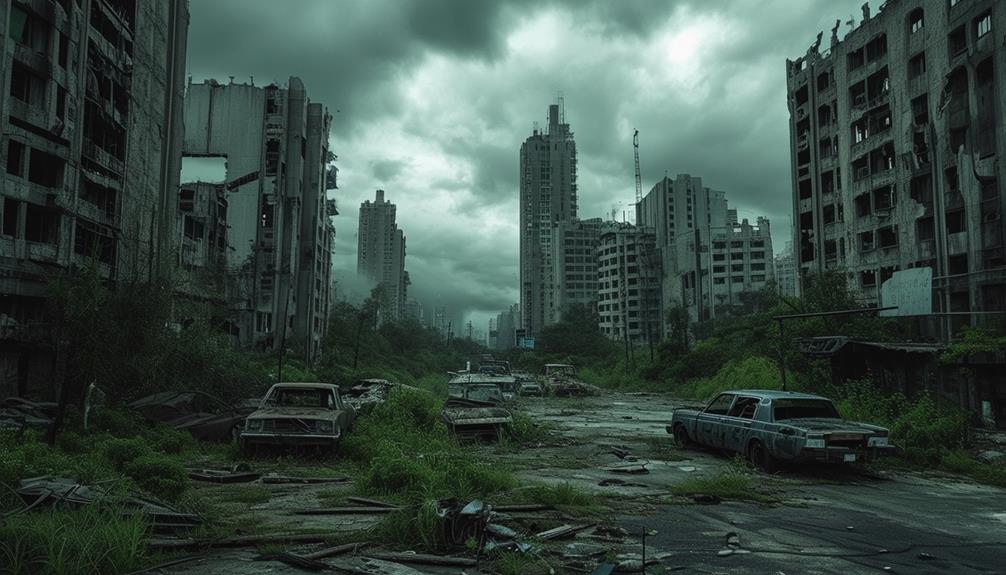Understanding Anarchy: What to Expect When Society Collapses

When society collapses, you may find yourself navigating a world where traditional governance has disintegrated, giving way to anarchy. In this new landscape, self-governance, mutual aid, and decentralized decision-making become essential components of daily life.
Communities will likely form new social structures focused on localized resilience. Anarchy provides an opportunity to rethink societal norms and equitable resource distribution, but it also presents challenges in maintaining order and managing power dynamics.
Curious about how to thrive in such a scenario and what historical examples can teach us?
Causes of Sociopolitical Collapse

Understanding the causes of sociopolitical collapse is crucial for grasping how societies can unravel. One key factor is increasing complexity. As societies grow, they develop intricate systems and structures. While complexity can bring short-term benefits, it also comes with diminishing marginal returns. Fundamentally, the more complex a society becomes, the harder it is to manage and sustain.
Elite mismanagement and exploitation exacerbate these issues. When those in power overcompensate for problems without addressing root causes, they add layers of complexity that strain the system further. This spiraling complexity can weaken the economy, making society more vulnerable to collapse. Technological advancements and energy subsidies might offer temporary relief, but they often only delay the inevitable.
When complexity reaches a tipping point, the society's ability to adapt and respond effectively diminishes. The economy spirals out of control, causing widespread instability. These internal pressures can eventually lead to sociopolitical collapse.
Recognizing these factors and understanding their interplay is essential for anticipating and possibly mitigating the unraveling of societies.
Historical Collapse Examples
To understand societal collapse, consider the fall of the Western Roman Empire and the disappearance of the Olmec civilization. The Roman Empire crumbled due to factors such as authoritarianism, economic troubles, and resource depletion, while the Olmecs faced a mysterious disintegration that may have been influenced by environmental changes and internal strife.
These examples highlight how complex systems and mismanagement, along with external pressures, can lead to a society's downfall.
Roman Empire's Downfall
When examining the downfall of the Western Roman Empire, several key factors come to light: authoritarianism, complexity, and resource challenges. The empire's intricate bureaucracy and military demands created a complex system that became increasingly difficult to manage. As the system expanded, the benefits of its complexity diminished, leading to inefficiencies and vulnerabilities.
Authoritarian rulers often aggravated these issues by prioritizing short-term gains over long-term stability. This mismanagement by the elite drained resources and weakened the empire's ability to respond to crises. Economic exploitation further strained the population, causing widespread dissatisfaction and rebellion.
Resource challenges also played a significant role. The empire relied heavily on agricultural output and human labor, but as these resources became overextended, the economic foundation began to crumble. When essential resources like grain and labor fell short, the empire couldn't sustain its vast infrastructure and military might.
The collapse led to major population loss and economic repercussions, affecting all social strata. By understanding these historical lessons, we gain insight into how modern societies might also struggle with complexity, mismanagement, and resource depletion, potentially leading to their own forms of decline.
Olmec Society's Disintegration
The gradual disintegration of Olmec society in Mesoamerica involved a combination of environmental degradation, political upheaval, and declining trade networks.
Environmental degradation severely impacted their agricultural systems. Soil exhaustion and deforestation likely reduced crop yields, leading to food shortages and population decline.
Political instability also played a crucial role. The Olmecs' centralized power structures may have become unstable, leading to internal conflicts and weakened leadership. This instability made it challenging to maintain social order and manage resources effectively.
Declining trade networks further accelerated the collapse. The Olmecs relied on extensive trade routes to acquire vital goods and materials. As these networks deteriorated, access to necessary resources diminished, exacerbating their existing problems.
As these factors combined, major urban centers like La Venta and San Lorenzo were abandoned. The disintegration was gradual, unfolding over several centuries, creating a power vacuum that allowed successor civilizations like the Maya and the Zapotec to rise.
Archaeological evidence suggests this collapse was a complex process involving multiple interconnected factors, making the Olmec society's downfall a poignant example of how environmental, political, and economic issues can intertwine to bring about societal collapse.
Complex Societies and Collapse

In complex societies, elite mismanagement often leads to severe consequences. As these societies expand, they encounter diminishing returns on their complexity, making it increasingly difficult to sustain stability.
Additionally, resource depletion exacerbates the situation, pushing these societies closer to potential collapse.
Elite Mismanagement Consequences
Elite mismanagement often triggers societal collapse by fostering exploitation, overindulgence, and diminishing returns on complexity. When those in power prioritize their interests, they exploit resources and people, creating unsustainable systems that buckle under their own weight. For instance, the Western Roman Empire's downfall was accelerated by authoritarianism and mismanagement, leading to strained resources and economic decline.
In complex societies, elite mismanagement can spiral out of control, weakening economies and increasing societal strain. Leaders often overcompensate for problems by introducing more layers of bureaucracy and regulations, which only contribute to complexity without solving the underlying issues. This cycle of overindulgence amplifies inefficiencies, resulting in diminishing returns on every additional effort or investment.
Historians and theorists like Joseph Tainter emphasize that centralized control and mismanagement by elites often lead to collapse. When the ruling class focuses on maintaining their power and wealth, they neglect broader societal needs, leading to significant population loss and economic downturns. While some segments of the population may experience short-term economic gains, the overall impact of elite mismanagement is devastating for society as a whole.
Diminishing Returns Dynamics
Societies that grow increasingly complex often face diminishing returns, where further efforts and investments yield progressively smaller benefits. As societies evolve, they introduce more social differentiation, economic specialization, and centralized control to solve emerging problems. However, if not managed effectively, these complexities can backfire, making the system more precarious and prone to collapse.
To make this clearer, consider the following table:
| Complexity Factor | Initial Benefit | Subsequent Returns |
|---|---|---|
| Social Differentiation | High | Low |
| Economic Specialization | High | Declining |
| Centralized Control | High | Diminishing |
| Problem Solving | Effective | Ineffective |
In complex societies, the initial benefits of adding layers of social differentiation or economic specialization are high. However, as you continue to add more layers, the returns start to decline. Historical examples like the Western Roman Empire illustrate how unchecked complexity, combined with elite mismanagement and resource depletion, can lead to collapse.
Understanding the dynamics of diminishing returns in complex societies is essential for addressing modern challenges. Recognizing the point at which added complexity no longer yields significant benefits allows for better management of societal growth and can help avert potential crises.
Resource Depletion Impact
The phenomenon of resource depletion plays a critical role in the potential collapse of complex societies. Historical instances, such as the decline of the Western Roman Empire, illustrate how the exhaustion of essential resources can disrupt social and economic structures, contributing to systemic failure.
In contemporary settings, the implications of resource depletion remain dire. Modern societies heavily depend on a variety of resources to sustain centralized control and economic specialization. As these resources become scarce, it becomes increasingly difficult to meet the needs of the population, leading to potential social and economic breakdowns.
The theory of resource depletion as a catalyst for societal collapse highlights the necessity of sustainable resource management. Societies reliant on finite resources must proactively address these risks to avoid similar downfalls.
Impact on Social Strata
The collapse of society significantly reshapes the lives of various social strata, leading to both substantial gains and severe losses. One of the most immediate and devastating effects is population loss, which disproportionately impacts different social classes.
In highly industrialized societies, societal breakdown can lead to a drastic reduction in population due to factors like food shortages, lack of medical care, and general chaos. This population loss often hits lower social strata the hardest, as they generally lack the resources to mitigate these adverse effects.
However, societal collapse can also dissolve rigid hierarchies. For individuals in lower social strata, the breakdown of established structures might offer unexpected opportunities. Without the constraints of strict societal norms and economic barriers, some may find new ways to thrive, at least temporarily.
Conversely, the upper echelons of society, who rely on the existing system for their privileged status, may experience a sharp decline in their standard of living.
Understanding these dynamics is essential for grasping how different classes are affected and underscores the importance of planning for resilience. In a collapsing society, the impact on social strata is complex, involving both catastrophic losses and surprising gains.
Community Response to Disasters

Communities often come together during disasters, showing remarkable resilience and cooperation. People tend to exhibit pro-social behavior, forming alliances and helping others in need. This collective response can be influenced by factors such as government aid, law enforcement actions, and community stability. For example, a prompt and effective response from local authorities can bolster community efforts and enhance unity.
Disasters often forge new social bonds and relationships within affected communities. Faced with adversity, individuals find common ground and work together, leading to stronger personal connections. Neighbors who barely interacted before may suddenly pool resources and support each other.
In the chaos of disasters, new organizational structures and alliances often emerge to allocate resources effectively. These spontaneous formations are vital for survival, helping distribute food, water, and medical supplies to those in need. By working together, communities can navigate the immediate aftermath of disasters more efficiently, ensuring everyone receives the necessary aid.
Rebuilding After Catastrophes
After the immediate chaos of a disaster subsides, survivors often focus on rebuilding their lives and communities, a process essential for creating a new normal and fostering resilience. Historically, people have demonstrated a remarkable ability to regroup, organize, and rebuild society after catastrophic events. New organizational structures and alliances typically emerge to efficiently allocate resources.
Strong personal connections and social bonds play a crucial role in the rebuilding process. People often form deep friendships, share resources, and support each other during these challenging times. Post-collapse scenarios frequently witness the strengthening of these connections, which become the backbone of new communities.
Key aspects of successful rebuilding efforts include:
- Resource Allocation: New alliances ensure resources like food, water, and shelter are distributed equitably.
- Community Bonds: Strengthened social bonds foster cooperation and mutual support.
- Resilience: Societies exhibit an incredible capacity to recover and establish a new normal.
In the aftermath of a catastrophe, it's essential to focus on these elements to effectively rebuild and establish a stable and supportive community. Understanding these dynamics is crucial for navigating post-collapse scenarios.
Pop Culture Apocalyptic Views

Apocalyptic narratives in pop culture often depict human nature at its worst, filled with violence and mistrust. Movies, books, and TV shows like _The Walking Dead_ and _It Comes at Night_ showcase societies where trust and kindness are scarce. These stories emphasize how quickly human nature can devolve when societal structures collapse, highlighting scenes of extreme violence and betrayal. Prepper fiction portrays a world where the weak attempt to exploit the prepared, reinforcing the notion that in a collapsed society, it's every person for themselves.
Consider the emotional impact of these narratives:
| Emotion | Scene | Impact |
|---|---|---|
| Fear | Zombies attacking survivors | Heightened sense of vulnerability |
| Desperation | Families hiding from scavengers | Hopelessness |
| Suspicion | Neighbors turning on each other | Breakdown of community trust |
| Loneliness | Characters wandering alone | Isolation and sadness |
| Despair | Abandoned cities and desolation | Loss of hope and future dreams |
While pop culture suggests that human nature defaults to chaos and violence, historical evidence shows that communities often come together in times of disaster. However, these dark portrayals captivate audiences by tapping into our deepest fears about societal collapse.
Anarchist Perspectives and Strategies
Anarchist perspectives offer a vision of self-governance and mutual aid, especially relevant in times of societal collapse. Anarchists reject hierarchical structures, advocating instead for autonomy and decentralized organization. By focusing on collective decision-making and mutual support, they aim to create a more equitable society.
These perspectives are particularly pertinent in the context of climate change, where traditional systems often fail under environmental stress. Anarchists emphasize direct action and solidarity to build resilient communities. They challenge oppressive systems and promote sustainable practices that prioritize the well-being of both individuals and the planet.
Key anarchist strategies include:
- Dismantling oppressive systems: Actively resisting and breaking down structures that perpetuate inequality and exploitation.
- Promoting mutual aid: Establishing networks for communities to share resources and support each other, particularly in times of crisis.
- Fostering direct action: Encouraging immediate, community-driven responses to problems rather than relying on hierarchical institutions.
Predictions for Modern Societies

Given accelerating climate change and geopolitical instability, modern societies face unprecedented challenges that demand immediate and decisive action. Global carbon dioxide emissions hit a record 36.3 billion tons in 2021, exacerbating climate change and pushing ecosystems to the brink. If emissions aren't drastically reduced by 2025, projections suggest severe impacts on food systems and biodiversity, potentially leading to widespread societal disruptions.
The number of international refugees is expected to exceed 30 million this year, underscoring the severity of global instability. Conflicts, natural disasters, and economic disruptions are driving this mass displacement, straining already fragile state infrastructures. Supply chain disruptions and inflation are further accelerating state failures, posing significant governance challenges.
Climate models may be underestimating future scenarios, raising concerns about the adequacy of current projections. As these crises converge, modern societies must prepare for potential systemic breakdowns. The interconnected nature of these issues means that a failure in one area, such as food production, could trigger cascading failures across other sectors.
It is crucial to stay vigilant and proactive, advocating for sustainable practices and robust policies to mitigate these looming threats and prevent societal collapse.
Conclusion
In the event of societal collapse, you'll navigate a world where traditional structures no longer exist. Embrace self-governance and rely on your community for mutual aid. This is an opportunity to redefine societal norms and strive for fair resource distribution.
However, anticipate challenges in maintaining order and addressing power dynamics. Stay resilient, adaptable, and proactive in rebuilding a more equitable, decentralized future. Remember, your actions will shape the new social landscape.




